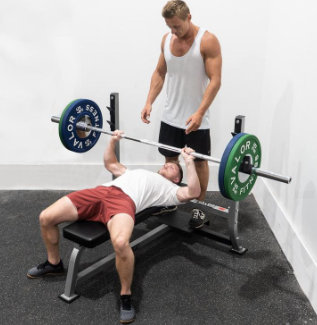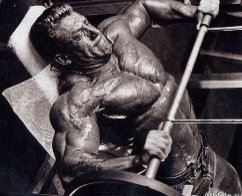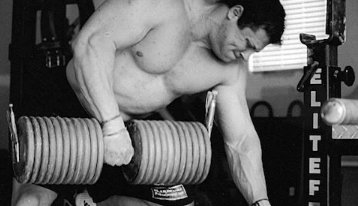Heavy Duty is a really intense bodybuilding workout that breaks the norm of routines you have known until now. When you learn more about this training system, you may even be shocked. We have always heard that the best thing for muscle growth is to do a few sets of several repetitions for each exercise, right? So-called high volume training has been the preference of bodybuilders like Arnold Schwarzenegger. However, other big names in bodybuilding advocate doing very few training sets, but very heavy ones and with great intensity. This is what a Heavy Duty routine consists of: it is risking everything in a single set or a couple of sets. No more than that!
Heavy Duty training has been a favorite of renowned bodybuilders such as Dorian Yates and Mike Mentzer. Understand this training methodology, because maybe it will work very well for you too!
What is a Heavy Duty workout?
Heavy Duty means "carry out a heavy task". Therefore, the name of the training honors the way of working with this system. We are already anticipating that it is going to be a very heavy training session. The basic approach to a Heavy Duty routine is as follows:
• Some warm-up and approximation sets are done for an exercise (for example, 2 or 3 sets or as many as necessary).
• Afterwards, 1 or 2 work sets are done until muscle failure or close to it.
* Sometimes, the athlete can go even beyond muscle failure with different intensity techniques such as forced, negative and partial repetitions.
If you want to learn more about warming up for workouts or intensity techniques in bodybuilding, don't miss these two articles.
Are you interested? :
The approach to Duty Heavy is very easy: less is more in terms of muscle gain. Why do 4 or 5 sets of an exercise when you can squeeze out your full potential with just 1 or 2 sets. Of course, be prepared to train with maximum intensity in those few sets. Dorian Yates and Mike Mentzer have opted for this maximum intensity method.
Heavy Duty training according to Mike Mentzer

Mike Mentzer was one of the most popular bodybuilders of all time, thanks to his impressive physique, innovative and controversial training approach, and laid-back personality. Mentzer was one of the few men to win the Mr. Universe title in 1978 with perfect scores, as well as one of the first bodybuilders to popularize high-intensity training as a means to seriously build muscle. He believed it was possible to quickly increase muscle size and strength through short but intense workouts.
Although Mike Mentzer died in 2001 at the age of 49, his ideas about bodybuilding continue to influence thousands of people around the world every year. However, there is still uncertainty about his exact training routine. This legendary bodybuilder of the 1970s also competed against Arnold Schwarzenegger and Frank Zan at Mr. Olympia, he placed fifth in 1980 and quit bodybuilding. Although he did not win the Mr. Olympia, Mike left a lasting mark on the world of bodybuilding after introducing his Heavy Duty training system to competitors.
The Heavy Duty system was different from other bodybuilding programs, and even quite different from bodybuilding workouts you may have seen. Instead of training for hours every day and doing dozens of repetitions like other bodybuilding programs, Mike Mentzer advocated intensity, training for short periods of time using heavy weights.
Mike believed that less is more when it comes to training. This made him a strong advocate of the training philosophy known as high intensity developed by Arthur Jones, who lifted heavy weights with relatively few repetitions and emphasized quality over quantity . According to Mentzer, this style of training produces the best results because it minimizes muscle damage and allows for more efficient training. However, his recommendations were controversial because they challenged conventional wisdom that more exercise was better.
The principles of Mike Mentzer
Mentzer had very clear ideas about what an ideal bodybuilding workout should be like. He collected these ideas in his book. Here is a summary of Mike Mentzer 's training principles in his book Heavy Duty in English.
• Avoid big training volume : This could lead to overtraining and loss of muscle mass, rather than growth.
• More intensity : The amount of effort you put into each set should increase as your body gets used to your routine. You should not train without energy and you should not do more than eight to ten repetitions per set, nor more than six working sets per body part. You can create more intensity by increasing the weight in a particular exercise.
• Train each muscle group once a week : Once a week is enough for each muscle. If you want to exercise a muscle group more than once a week, you are training too much and should not expect any results from your efforts.
• Adequate rest : There should be enough rest between exercises to allow your body to recover from the stress exerted during the last exercise. If you don't give your muscles enough time to fully rest and recover, you will not only stop progressing, but you may lose muscle if you train for too long.
• Fewer sets : Do just a few heavy sets per body part instead of multiple sets. If you do too many sets, your body won't have time to adapt or develop. If your workouts are short and infrequent, you can maintain consistent muscle growth for years.
Dorian Yates' Heavy Duty

The high intensity training method is much more than just doing a few repetitions. It involves really breaking down the muscles and breaking them down more than ever before, but generally at low volume. Mike Mentzer was a Golden Age bodybuilder who brought to the scene muscle mass that had never been seen before. Dorian Yates took it a step further by building even more muscle mass and won Mr. Olympia up to 6 times. Both competitors used an efficient, high-intensity, low-repetition training method. How did Dorian Yates apply Heavy Duty?
Dorian Yates opted to do a set until absolute failure in each exercise. This main sets will take the body to the full limit of its strength. How would Dorian Yates do the Heavy Duty? Let's say he was doing a set of barbell rows. Yates would first do a few warm-up sets of this exercise with a weight that was easy to move. After warming up, the bodybuilder would load the bar with as much weight as he could lift. Dorian would do 8 perfect repetitions with that weight until reaching muscle failure.
If Dorian Yates trained with a partner in the gym, he managed to do 2 or 3 more forced repetitions. Sometimes he would even take the set further and do a couple of negative or even pause reps to achieve maximum contraction. Of course, these intensity methods require the help of a training partner. With these techniques, you can achieve a single, extremely intense muscle-building set.

How do you know if you have applied Heavy Duty correctly ? If you've done your heavy set and feel like you could do a second set, this means you haven't followed all of the intensity rules from the first set.
You may think that reducing your entire training to just one effective set per exercise is too drastic a change, but have you tried it? Dorian Yates never believed in high-volume work. Yates used Mentzer's system to adapt it to his body type and personality.
The problem with traditional training of 3 or 4 working sets per exercise is how to manage the effort. With a traditional training approach, you are forced to reserve your strength during the first sets to complete the third or fourth set. In traditional bodybuilding workouts, you're always left feeling like you could have tried harder during most sets. When you do a single max effort set, you don't have such a problem. You know that there you have to give your 100% yes or yes.
Even if you could give your 100% in all three sets, the effect would be counterproductive. A single work set at 100% intensity is enough to achieve the goal. The message that your body needs more size and strength has already reached your muscles! To see it with a metaphor, consider the following example: if with a good blow of the hammer the nail has entered the wood the first time, why continue hammering after hammering? You will only ruin the wood and waste the good work you did with the first blow of the hammer.
According to Dorian Yates , sending a second or third message with more high-intensity sets hinders the muscle development process and means we have to spend more time recovering than growing.
"If you take my training philosophy as a solid foundation, you will be able to develop the rest of your body like a building."
-Dorian Yates.

Dorian Yates Heavy Duty Training PDF
Would you like to give this training a try? Here's a Dorian-style Heavy Duty routine in PDF . We have already tried it and it has worked for us! This gym routine is to gain muscle size and strength. The workout is low volume and high intensity. Follow the instructions we propose. This Heavy Duty training is for 3 days .
Ideally, rep ranges for the work set will be between 20 and 5 reps . We can start with a load that allows us to do 20 repetitions and increase the weight week after week until we get closer to 5 repetitions. It is important to be close to muscle failure or at muscle failure at the end of the work set.
Day 1: Chest, deadlift, biceps and shoulders
Monday
• Bench press :
- 3 warm-up sets.
- 2 work sets.
• Z bar biceps curl :
- 1 warm-up sets.
- 2 work sets.
• Conventional deadlift :
- 3 warm-up sets.
- 1 work set.
• Shoulder press with dumbbells while sitting on a bench :
- 1 work set.
• Preacher bench biceps curl :
- 1 work set.
• Military press standing with bar :
- 1 work set.
• Lateral raises with dumbbells :
- 1 work set.
• Biceps curl with dumbbells on an incline bench :
- 1 work set.
• Upright row :
- 1 work set.
• Reverse flyes in machine :
- 1 work set.
• Cross-over.
- 1 work set.
As you can see, in many exercises there is no need to warm up, since it is assumed that our body has already warmed up at the beginning and is prepared for the intense sets.
Day 2: Legs and triceps
Wednesday
• Squats :
- 3 or 4 warm-up sets.
- 2 work sets.
• French press with Z bar :
- 2 warm-up sets.
- 1 work set.
• Leg press :
- 3 or 4 warm-up sets.
- 2 or 3 work sets.
• Incline bench press with narrow grip in Multipower :
- 1 warm-up set.
- 1 work set.
• Quadriceps extension on machine :
- 2 work sets.
• Lying hamstring curl on machine :
- 2 work sets.
• Lunges with dumbbells :
- 2 work sets.
• Triceps extension on the cable :
- 1 work set.
Day 3: Chest and back
Friday
• Bench press :
- 3 warm-up sets.
- 2 work sets.
• Neutral grip pull-ups :
- 1 work set.
• Incline bench dumbbell flyes :
- 1 work set.
• Pendlay row with underhand grip :
- 1 work set.
• Dips on parallel bars :
- 1 work set.
• Lat pulldown with long and neutral handle :
- 1 work set.
• Dumbbell press on flat bench :
- 1 work set.
• Dumbbell row :
- 1 work set.
• Dumbbell pull-over :
- 1 work set.
• Flyes in Peck-Deck machine :
- 1 work set.

Heavy Duty Routine by Mike Mentzer PDF
Next up is a 5-day Heavy Duty training in the style of Mike Mentzer. The routine includes many warm-up sets and the effective ones typical of the high-intensity system. There are Mentzer's favorite exercises to work all parts of the pectoral muscle.
Day 1: Chest
Monday
• Incline bench dumbbell flyes :
- 3 warm-up sets.
- 2 work sets of 8 repetitions.
• Dips on parallel bars :
- 3 warm-up sets.
- 2 work sets of 6 repetitions (add weight if necessary and rest only 60 seconds between work sets).
• Bench press with barbell on inclined bench :
- 3 warm-up sets.
- 2 work sets of 6-8 repetitions.
• Barbell bench press on flat bench :
- 3 warm-up sets.
- 2 work sets of 6-8 repetitions.
• Flat bench dumbbell flyes :
- 3 warm-up sets.
- 2 work sets of 6-8 repetitions.
Day 2: Back
Tuesday
• Standing Lat Pushdown :
- 3 warm-up sets.
- 2 work sets of 5-8 repetitions.
• Lat pulldown with neutral grip :
- 3 warm-up sets.
- 2 work sets of 8-10 repetitions.
• Bent-over barbell row :
- 3 warm-up sets.
- 2 work sets of 5 repetitions.
• Standing Barbell Shrugs :
- 3 warm-up sets.
- 2 work sets of 8-10 repetitions.
• Upright row :
- 3 warm-up sets.
- 2 work sets of 6-8 repetitions.
Day 3: Shoulders
Wednesday
• Dumbbell rear lateral raises :
- 3 warm-up sets.
- 2 work sets of 8-10 repetitions.
• Shoulder press while seated on machine :
- 3 warm-up sets.
- 2 work sets of 6-8 repetitions.
• Lateral raises with dumbbells:
- 3 warm-up sets.
- 2 work sets of 8-10 repetitions.
• Shoulder press with barbell behind the neck :
- 3 warm-up sets.
- 2 work sets of 6-8 repetitions.
• Front raise with barbell :
- 3 warm-up sets.
- 2 work sets of 8-10 repetitions.
Day 4: Legs
Thursday
For Mentzer's leg workout, you can do even more repetitions than indicated in the routine.
• Single leg machine extension :
- 3 warm-up sets.
- 2 work sets of 8-10 repetitions.
• Single leg hamstring curl on machine :
- 3 warm-up sets.
- 2 work sets of 8-10 repetitions.
• Barbell squats :
- 3 warm-up sets.
- 2 work sets of 6-8 repetitions.
• Standing Calf raise :
- 3 warm-up sets.
- 2 work sets of 10-15 repetitions.
• Walking dumbbell lunges :
- 3 warm-up sets.
- 2 work sets of 8-10 repetitions.
Day 5: Arms
Friday
• Chin-ups:
- 3 warm-up sets.
- 2 work sets of 6-8 repetitions (add weight if necessary).
• Dips on parallel bars :
- 3 warm-up sets.
- 2 work sets of 10 repetitions.
• Z-bar preacher curl :
- 3 warm-upsets.
- 2 work sets of 8-10 repetitions.
• Cable triceps extension:
- 3 warm-up sets.
- 2 work sets of 8-10 repetitions.
• Standing barbell biceps curl :
- 3 warm-up sets.
- 2 work sets of 8-10 repetitions.
I want a 4 day Heavy Duty routine . Can I get it? Although we haven't shown a 4-day routine here, you can easily adapt the above workout to get one. Simply put, in Mentzer's workout, eliminate day 5 (Friday) and place the biceps and triceps exercises in the chest and back workouts (days 1 and 2). The training would be as follows:
Heavy Duty Routine 4 days
• Day 1 - Monday : Pectoral and biceps
• Day 2 - Tuesday : Back and triceps
• Rest - Wednesday
• Day 3 - Thursday : Shoulders
• Day 4 - Friday : Legs
Perform the exercises, sets and repetitions that we indicate in the Mentzer training.
Other training similar to Heavy Duty :
Download Heavy Duty workouts
Choose the PDF in the desired language and click on the download link:
Recommendations for the Heavy Duty gym routine
Learn about rest, recovery, and intensity principles applicable to the Heavy Duty consolidation routine .
Forced repetitions
Your training partner will help you complete more repetitions after you have completely failed. Bodybuilders like Tom Platz preached the principle of forced reps and said that when you're completely done, you have about five more reps.
Partial repetitions
Here, the lifter only completes part of the rep, so form is compromised quite a bit, but not to the point of clearly being at risk of injury and maintaining tension on the target muscle.
Negative repetitions
In negative reps, the training partner helps the lifter complete the positive portion of the rep. The lifter then holds the weight and lowers it slowly, usually over a set period of time. This keeps a lot of tension on the muscles.
Simply put, when it comes to doing high-intensity weight training, you need to push the weights to complete failure. Although high-intensity training consists of low repetitions, those repetitions involve maintaining a good mind-muscle connection and taking the final repetitions to failure and beyond. Strength training always encourages you to overcome muscle failure with techniques such as partial repetitions, forced and negative repetitions.
Recovery
To perform an intense workout, recovery must equal the intensity of the workout. High-intensity workouts destroy your muscles like never before, forcing you to focus even more on recovery. Recovery is where you really grow and muscle fibers are rebuilt and strengthened. What should you do to achieve recovery?

Days off
You really can't do an intense workout every day. The intensity should be divided between the exercises. For example, while classic bodybuilding workouts involves training each body part twice a week, Mike Mentzer preferred to train three days a week, with four days dedicated to rest and recovery . He divided his body into two parts and his exercises into A and B.
Dorian Yates, on the other hand, trained each muscle group once a week with 2-3 days of rest a week. The fact is that rest days are necessary to give the body a few days of training. This doesn't mean taking several weeks off from the gym, as frequency is still important, but if you're truly doing a high-intensity training program like Heavy Duty , you should take a few days off each week.
Sleep
During sleep, the body produces the most testosterone and human growth hormone, which are important for building muscle and maintaining health. With this in mind, continue to maintain a proper sleep schedule as a primary part of your recovery protocol.
Diet and nutritional supplements
Another important part of your recovery is diet. Eating the right foods for your muscles is vital for recovery and growth, especially after an intense workout.
In addition to dieting, supplements are equally important because they help ensure you get the right amount of macro and micronutrients (which you may not get through diet alone). Protein powder, creatine, and multivitamins are great supplements to promote recovery.
Finding the right exercises for Heavy Duty
If you have already carried out the Heavy Duty gym routines that we have shown, you may want to do new exercises in this workout. You can download any training application with strength and hypertrophy exercises to add to the program. Just remember to apply the Heavy Duty principles that we have explained here. Over time, you will learn to design your own high-intensity workouts.
Pros and Cons of the Heavy Duty Consolidation Routine

Advantages :
• Fewer training days and shorter sessions.
• Ideal for those who have obligations and not too much time to dedicate to the gym.
• Facilitates recovery and natural growth.
• Heavy Duty is for naturals because it is intense but does not fatigue the muscles excessively.
• It motivates you to improve yourself by training with heavy loads.
Cons :
• Some people consider just one or two "good" sets per exercise to be too little work.
• Low total work volume.
• It is not so recommended for those who like to spend a lot of time training and recover well with high volume training.
We recommend Heavy Duty for natural lifters
In general, strength training programs are not for the faint of heart. A high-intensity workout involves doing few repetitions, but they will be the most intense and demanding repetitions you have ever experienced. Plus, you really have to prioritize recovery.
Also lovers of high volume training have misinterpreted the Heavy Duty methods . Before each work set, Dorian Yates and Mike Mentzer applied an extensive and very hard warm-up to pre-exhaust the muscle. Let's say that the set that Dorian Yates considered "light" (for warming up) was already more intense than most of the sets that people generally consider "to muscle failure." For muscle stimulation, a few sets of maximum intensity are sufficient without exceeding the recovery capacity of the muscle and without overloading. Finally, we must also point out that Dorian Yates is one of the most injured bodybuilders of his career. Therefore, you must apply high intensity carefully and according to your limits, especially if you are a natural athlete.




![CÓMO MONTAR UN GIMNASIO EN CASA CON POCO PRESUPUESTO [GUÍA 2024]](/modules//smartblog/images/296-home-small.jpg)




